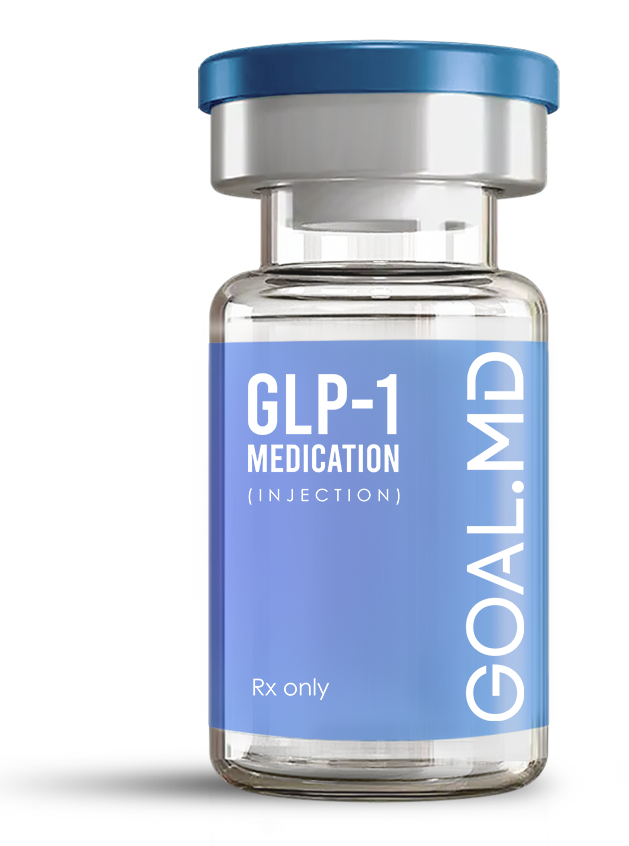
GOAL.MD Health & Wellness Blog
Evidence-based insights, medical weight loss information, and practical tips from our physicians and healthcare experts.

What Are the Side Effects of GLP-1 Medications?
GLP-1 receptor agonists like semaglutide (in Ozempic®, Wegovy®) and tirzepatide (in Mounjaro®, Zepbound®) have rapidly become game‑changers for weight loss. These injectable medications mimic a natural gut hormone that curbs appetite and slows digestion, so you feel full sooner and eat less. As demand has soared in popularity for treating obesity, many new users want to know what side effects to expect. The good news is that most side effects are well-known, manageable, and usually temporary.
Common GLP-1 Side Effects
The most frequent side effects involve the digestive (gastrointestinal) system. The list below covers what people usually experience:
Nausea: Queasiness or upset stomach (often mild).
Vomiting: Rarely, nausea may lead to vomiting if you eat too much too fast.
Diarrhoea: Loose or frequent stools.
Constipation: Difficulty or infrequent bowel movements.
Other symptoms: Some people also report fatigue, dizziness, or headaches.
By far, the most common complaints are GI-related. These symptoms typically occur during dose increases. (Injection-site redness or itching can happen too, but GI upset is most common.) In most cases, these side effects are mild to moderate and improve over time as your body adjusts. For example, clinical trials found that 98% of semaglutide side effects were mild or moderate, and 99.5% were non‑serious.
Table: Typical GLP-1 Side Effect Rates by Dose
Data from Wegovy (semaglutide) and tirzepatide clinical trials
Sources: In trials of Wegovy, about 44% experienced nausea (30% diarrhoea, 24% vomiting, and constipation). Tirzepatide (Mounjaro) shows a dose-dependent trend: at 5 mg, nausea/diarrhoea occurs in ~13%, and at 15 mg ~24% experience nausea and ~21% diarrhoea. (Lower doses have correspondingly lower rates.) Across studies, most GI effects were mild to moderate and transient.
Managing Side Effects
Fortunately, simple habits can greatly reduce discomfort. Smaller, gentler meals are key. Try eating 4–6 small portions a day instead of three large meals. Slow down, chew thoroughly, and stop eating as soon as you feel full. Avoid heavy, greasy, or very spicy foods during the first weeks. Favour bland, easy-to-digest foods (crackers, broth-based soup, bananas, rice, toast), which tend to be easier on the stomach.
Stay hydrated and include light fibre. Sip water (or clear broths and mild tea) throughout the day rather than drinking large amounts at once. Adequate fluids help prevent headaches and constipation. Eat fruits, vegetables, and whole grains to gently support regular bowel function.
Natural remedies like ginger or peppermint can ease nausea for some people. Try ginger tea, ginger chews, or ginger ale (made with real ginger) and peppermint tea or candies. These are generally safe, but let your doctor know if you use herbal remedies.
Other tips to try:
Do not skip meals. Even if you have little appetite, give your body steady nourishment. Balanced meals prevent blood sugar dips that can worsen nausea.
Eat slowly. Lying down or rushing right after meals can trigger reflux. Stay upright for 30+ minutes after eating.
Don’t ignore early signals. Stop eating at the first hint of queasiness, even if your plate isn’t empty. You can save leftovers for later.
“Go low and slow” on the dose. Work with your provider to start at the lowest dose and increase gradually. Slower titration lets your body adapt with fewer side effects.
Avoid trigger foods or smells. When you feel nauseated, skip rich sauces, fried foods, and heavy desserts. Strong odours (perfume, smoke, cooking smells) may also worsen nausea, so minimise them while you’re sensitive.
Listen to your body. Rest, fresh air, deep breathing, or relaxation techniques can help when you feel queasy or fatigued.
In some cases, your doctor may prescribe a short course of anti‑nausea medication to help during the first few weeks. But often no extra meds are needed long-term if you use the above strategies. Remember: these tips are preventive. They help you tolerate the medication so you can stay on a dose that will give you the best weight loss benefit.
Temporary Effects and Dose Titration
It’s important to note that side effects usually fade over time. In trials, most people saw GI symptoms only during the early dose ramp-up—as the medication reached its full dose—and then the symptoms subsided. Nearly all side effects were described as “mild-to-moderate” and “transient.” Indeed, patients who stayed on therapy typically found that nausea, vomiting, and diarrhoea became much less bothersome after a few weeks.
Careful dose titration is the main reason for this improvement. By staying on each dose for the recommended time (usually 4 weeks) before moving up, your body learns to adjust. If a side effect lingers or worsens, consult your provider—they may hold you at the same dose for longer before increasing. Above all, consistency pays off: stick with the plan, and many people see their side effects fade as their bodies adapt, while the weight loss continues.
For example, one analysis found that only 4.3% of patients discontinued semaglutide due to GI issues, and almost all side effects were mild/moderate. This means the vast majority of users stay on their treatment and reap its benefits.
If at any point your side effects feel unmanageable, remember you have support. The medical team at GOAL.MD can guide you through dose adjustments and offer personalised advice to keep you on track.
Stay the Course and Get Support
GLP-1 drugs are powerful tools for weight loss, but success depends on sticking with the plan. Keep your appointments and communicate any concerns to your provider. Knowing that side effects are usually temporary can help you stay motivated. Many patients are thrilled with their weight loss and find that early discomfort was well worth it in the end.
Ready to get started or need help managing your treatment? Get qualified through GOAL.MD to speak with our weight-loss physicians. We offer personalised GLP-1 programs that include expert guidance on dosing and side effect management. With our support, you can navigate the first few weeks smoothly and stay on course toward your health goals.
Disclaimer: All product and company names, including brand names such as Novo Nordisk or Eli Lilly, are the property of their respective owners. This blog is not affiliated with, endorsed by, or sponsored by any of these companies.
Why GOAL.MD?
✅ Sourced from audited 503a US compounding pharmacies.
✅ Custom dosages adjusted to your needs.
✅ Free consultation + 24/7 support.

How It Works
1. Quiz
90 seconds. No commitment.
2. Consult
Video chat with your GOAL.MD doctor.
3. Deliver
Meds at your door tomorrow.
Transform Your Life with Physician-Directed Care
Join thousands who've found success with physician-directed care. Take our 3-minute quiz to see if medical weight loss is right for you.








